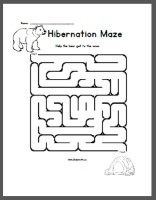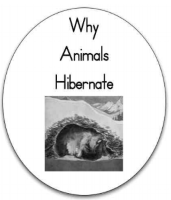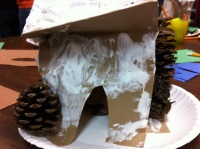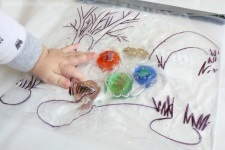Hibernation -- Preschool & Kindergarten
Hibernation
Fingerplays/Songs
Bear is Sleeping
tune: Frere Jacques
Bear is sleeping. Bear is sleeping
Let it snow! Let it snow!
Sleeping all the winter, sleeping all the winter
Snug and warm, snug and warm.
Hibernation Song
tune: Frere Jacques
Bear is sleeping, Bear is sleeping.
In a cave, In a cave.
I wonder when he'll come out,
I wonder when he'll come out.
In the spring, In the spring.
Story Video
Bears
Stain Glass Bear
Need: Contact Paper, Tissue Paper, Googly Eyes
Give the children the contact paper cut out as a bear. Have the children tear and place on the contact paper shape different colors of tissue paper Hang the children's creations in the window for a beautiful stained glass look.
Hibernation Bear Art & Write
Hibernation Celebration
This is a special celebration at the conclusion of a unit on hibernation. The children make bear caves from grocery bags which are painted and decorated. We use cotton balls on top for snow. The children and teachers wear their pajamas and bring their favorite teddy bear to school. When they arrive we put the bears in their caves and place them around the room.
In addition, we make "Bear Biscuits" using two refrigerator
biscuits. One for the face and the second one to form nose and ears.
Add raisins for the eyes and a maraschino cherry for the nose. When
the biscuits are baked we sit together around the room with our bears
and caves to partake of our special treat.
Contributed by: Jo Hamilton
When Winter Comes - animals tell how they hibernate mini book.
Book
Time To Sleep
by Denise Fleming
Hibernation Video
Art
The Bears Are Still Awake - Hibernation Craft at The Bears Are Still Awake - Hibernation Craft
Science
Conserving Energy
Hibernation not only eliminates the need for winter food-gathering, but also lets an animal conserve its body energy by slowing down its heart rate and breathing.
To illustrate an animal conserving energy, during a quiet time set a timer and have the children take their pulses or feel their heart during a one-minute interval Then have the children notice their breathing. Fast? Slow?
Have the children stand at their desk (or in the group area) and perform vigorous exercises (jumping jacks, hopping on one foot then the other foot) for several minutes. Afterward, have them sit and take their pulses or feel their heart again. How is their breathing? How is their pulse/heart beating? Is there a difference? What is the difference? Does rest or activity require more energy?
Heartbeat Experiment
Take one of the children’s pulse, which should be between 80 and 130 beats per minute. A woodchuck's (groundhog) heart beats 4 beats per minute when it hibernates. Have the children imagine their heart beating only 5-10 times per minute, like a hibernating animal’s.
Body Temperature Experiment
A lower body temperature reduces the amount of energy an animal must use to keep warm. A lower body temperature less energy used. The average body temperature of a mammal is 99ºF (37ºC), a hibernating animal's temperature drops to or below 43ºF (6ºC)
To demonstrate an animals lower temperature when hibernating, half-fill a tub or bucket with warm water and measure the temperature using a thermometer. Have children add ice cubes a few at a time and take a temperature reading after each addition.
When the temperature gets in the 50's (10's Celsius) add one ice cube at a time until the water reaches 43ºF (6ºC). Have the children place their hands in the water to experience the body temperature of a hibernating animal. Do they think they could sleep comfortably at this temperature?
Book
Bear Snores On
by Harcourt School Publishers
Story Video
Group Time
Musical Hibernation Game
Need: Tape/cd player lively music carpet tiles or mats
Describe the concept to the children that some animals sleep all winter. Bring out the mats or carpet tiles; one for each child. Explain to the children that while the music is playing the animals(them) are dancing. When the music stops it is winter time and it time to find a spot to sleep. As the days go on and the children know more animals. You can ask them what animal they are when they sleep. Contributed By: Vanessa S.
Hibernation Game ( who woke the sleepy bear!)
Need: Group of children, 5 or more ,the more children the harder the game gets!
Directions: Have all the children sit in a circle. One child will sit in the middle and pretend to sleep all curled up like a bear hibernating. Make sure their eyes stay closed!
Pick a child and have them sneak up and touch the bear then quickly return to their spot in the circle. Then everyone in the circle says WAKE UP SLEEPY BEAR! WAKE UP! and the child will then sit up and have to guess who woke them up. Let them guess 3 times. You can vary the game by letting them ask 3 questions such as was it a boy do they have on a red
shirt ex. Contributed by: Lindsay
Story & Craft
Animals In Winter
by Henrietta Bancroft
Learning Centers
Hibernation Time
Have a container that can be used for a cave. A gallon ice cream tub covered in brown paper works well. Lay the tub on its side. On the first day of winter, put a small stuffed bear into the tub and place a sign on it, Sleeping! Do not disturb until spring. On the first day of spring have a Teddy Bear Party, and bring the bear out of the tub.
Make A Hibernation Sensory Bag to Explore Animals in Winter at School Time Snippets

















